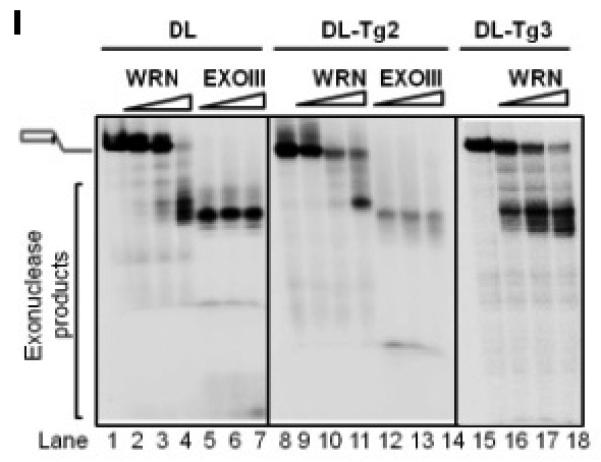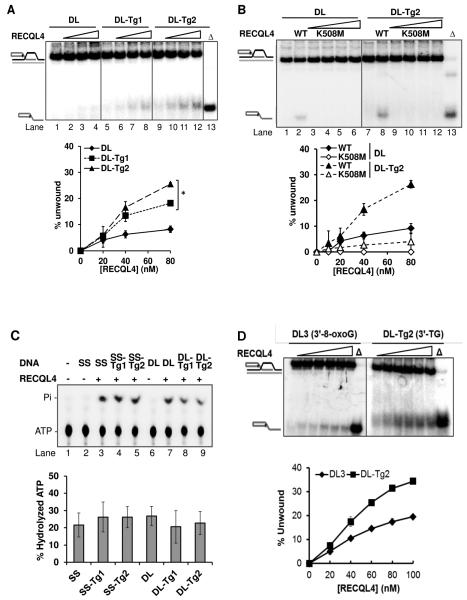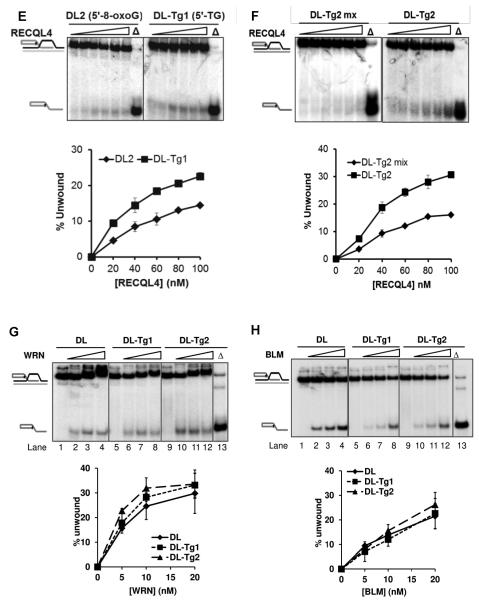FIGURE 2. RECQL4 shows unique preference towards telomeric D-Loops containing thymine glycol.

(A) Gel and quantitative analysis showing the unwinding capacity of 20, 40 and 80 nM RECQL4 on D-Loops with and without thymine glycol (Tg) lesions: DL (an undamaged D-Loop; lanes 1-4), DL-Tg1 (containing a Tg lesion toward the 5′ end of the invading strand; lanes 5-8) and DL-Tg2 (containing a Tg lesion toward the 3′ end of the invading strand; lanes 9-12), each at 0.5 nM concentration in the reaction. “Δ” (lane 13) indicates heat-denatured substrate. (B) Gel and quantitative analysis showing the unwinding capacities of RECQL4 WT and K508M on D-Loops with and without Tg. Unwinding activity of 10, 20, 40 and 80 nM RECQL4 K508M on DL (lanes 3-6) or DL-Tg2 (lanes 9-12) are compared with those of wild type RECQL4 (lane 2 or 8). (C) A representative phosphor image of thin-layer chromatography and quantitative analysis showing the effect of DNA cofactors with and without Tg lesions on ATP hydrolysis. (lane 2-3,SS; lane 4, SS-Tg1; lane 5, SS-Tg2; lane 6-7, DL; lane 8, DL-Tg1, lane 9, DL-Tg2) (D) Gel and quantitative analysis with increasing concentrations of RECQL4 (20-100 nM) on telomeric D-loops containing either 8-oxoguanine (DL3) or Tg (DL-Tg2) located towards the 3′- end of the invading strand. (E) Gel and quantitative analysis with increasing concentrations of RECQL4 (20-100 nM) on telomeric D-loops containing either 8-oxoguanine (DL2) or Tg (DL-Tg1) located towards 5′- end of the invading strand. (F) Gel and quantitative analysis with increasing concentrations of RECQL4 (20-100 nM) on telomeric D-loop containing Tg (DL-Tg2) and non-telomeric D-loop containing Tg (DL-Tg2 mix). (G and H) Gel and quantitative analysis showing the comparable unwinding capacity of 5, 10 and 20 nM WRN (G) and BLM (H) on the same substrates as in A, as indicated. (I) Representative gel showing the effect of Tg lesions on the activity of 5, 10 and 20 nM WRN exonuclease (lanes 1-4 DL; lanes 8-11 DL-Tg2; and additionally lanes 15-18 DL-Tg3) compared with E. coli EXOIII (lanes 5-7 DL; lanes 12-14 DL-Tg2). *P<0.05 by a t-test.


